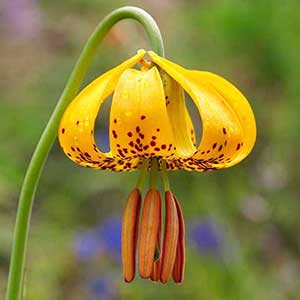Lilium humboldtii
Lilium columbianum
Humboldt lily, Humboldt's lily
Columbia lily, Columbia tiger lily, Columbian lily, Oregon lily, tiger lily
often somewhat purplish, variable, subrhizomatous to ± ovoid, 3.3–11.7 × 2.4–14.4 cm, 0.4–2.6(–3) times taller than long;
scales unsegmented or notched, longest 3.5–11.2 cm;
stem roots present or absent.
variable, subrhizomatous to ± ovoid, 3.1–8.1 × 3.6–10.6 cm, 0.3–1.4 times taller than long;
scales 2–3(–5)-segmented, some unsegmented, longest 3.1–7.3 cm;
stem roots absent.
to 3.1 m. Buds rounded in cross section.
to 1.7 m, glaucous or not.
rounded in cross section.
in 2–8 whorls or partial whorls, 3–16(–28) leaves per whorl, usually ascending, 4.6–14.5 × 0.8–3.6 cm, 2.9–7.2 times longer than wide;
blade usually ± oblanceolate, though often weakly so, rarely elliptic or lanceolate, margins usually undulate, apex acute;
veins and margins ± smooth abaxially.
in 1–9 whorls or partial whorls, 3–25 leaves per whorl, usually ascending, 1.7–15.7 × 0.4–4.7 cm, 2.4–7.4 times longer than wide;
blade weakly oblanceolate to obovate or ± elliptic, margins usually somewhat undulate, apex acute;
veins and margins ± smooth abaxially.
racemose, 1–33(–40)-flowered.
racemose, 1–25(–45)-flowered.
pendent, not fragrant;
perianth Turk’s-cap-shaped;
sepals and petals reflexed 1/5 along length from base, orange or yellow, with prominent red or magenta spots, not distinctly clawed;
sepals not ridged abaxially, 5.2–9.8 × 1.4–2.4 cm;
petals 5.6–9.6 × 1.5–2.9 cm;
stamens strongly exserted;
filaments parallel along most of length, then very widely spreading, diverging 17°–31° from axis;
anthers purple, 1.1–1.9 cm;
pollen rust, tan, or peach, becoming yellow or tan-yellow;
pistil 4.6–7.1 cm;
ovary 1.2–2.6 cm;
style green, often pale;
pedicel 7.8–21.2 cm.
pendent to nodding, not fragrant;
perianth Turk’s-cap-shaped;
sepals and petals reflexed 2/5–1/2 along length from base, yellow or orange to occasionally red, with copious maroon spots, often darker and especially reddish abaxially, not distinctly clawed;
sepals not ridged abaxially, appearing wide for their length, 3.4–7.1 × 0.8–1.9 cm;
petals 3.5–6.9 × 0.8–1.9 cm;
stamens barely to moderately exserted;
filaments moderately spreading, diverging 10°–20° from axis;
anthers pale yellow to yellow, 0.5–1.3 cm;
pollen orange or yellow;
pistil 2.4–3.7 cm;
ovary 1.1–2.2 cm;
style green;
pedicel 2.8–20.2 cm.
longitudinally keeled, 2.5–5.4 × 1.8–3.3 cm, 1.1–2.3 times longer than wide.
2.2–5.4 × 1.1–2 cm, 1.7–3.3 times longer than wide.
not counted.
135–330.
= 24.
Lilium humboldtii
Lilium columbianum
Subspecies 2 (2 in the flora).
Lilium humboldtii is declining throughout its range due to habitat destruction, primarily for housing. Forming large scattered colonies at foothill elevations under ponderosa pines or in oak canyons and chaparral, these massive plants with towering inflorescences and large flowers are quite striking. With Lilium pardalinum and L. parryi, they were used in the early part of the century to produce the Bellingham hybrid lilies, development of which continued with the Bellmaid hybrids. Though not as popular as various Asiatic hybrids, these are still in use.
A. M. Kellogg was aware as early as 1859 that the tall, orange-flowered, dry-land lily from the foothills of the Sierra Nevada was distinctive, and he presented this opinion to the California Academy of Sciences about that time (A. M. Kellogg 1872). By the time he had published a description attached to the name Lilium bloomerianum, P. E. S. Duchartre had described this same plant from material provided by B. Roezl and grown by M. Leichtlin, and named it after the German explorer and botanist Alexander von Humboldt. Carl Purdy and others then misapplied Kellogg’s name in various combinations to the southern California expression recognized here as Lilium humboldtii subsp. ocellatum.
The Humboldt lily is pollinated primarily by large butterflies, especially western tiger swallowtails (Papilio rutulus Lucas, family Papilionidae) and pale swallowtails (P. eurymedon Lucas), and to a lesser extent by the monarch butterfly [Danaus plexippus (Linnaeus), family Nymphalidae].
(Discussion copyrighted by Flora of North America; reprinted with permission.)
The author citations often seen for this species derive from Baker (1874), who published the name as Lilium columbianum “Hanson in hort., Leichtlin”; this authority is given by various later writers as Hanson, or Baker, or Hanson ex Baker. However, Ducharte’s (1871) recapitulation of a letter from M. Leichtlin is apparently the first confirmed and valid publication of L. columbianum, and hence that citation is used here.
This widespread lily is rather variable. In California plants the stamens are considerably less exserted than those of plants found farther north. Lilium columbianum may intergrade with L. kelloggii along Highway 199 at the border between California and Oregon; these plants are slightly fragrant, the stamens moderately exserted, and the bulb scales unsegmented. Lilium columbianum hybridizes with L. pardalinum subspp. wigginsii and vollmeri, and extensively with L. occidentale in Oregon.
Lilium columbianum is pollinated primarily by rufous hummingbirds [Selasphorus rufus (J. F. Gmelin), family Trochilidae] and to a lesser extent by large butterflies, including the pale swallowtail (Papilio eurymedon Lucas, family Papilionidae).
Native Americans used Lilium columbianum bulbs as a food or peppery condiment, sometimes mixed with meat or salmon roe. For many, it was a staple food (J. Pojar and A. MacKinnon 1994).
(Discussion copyrighted by Flora of North America; reprinted with permission.)
1. Sepals and petals orange, spots magenta, without lighter red margins; bulbs off white, occasionally flecked with purple, scales always unsegmented; foothills of Sierra Nevada. | subsp. humboldtii |
1. Sepals and petals yellow or light orange, spots red or magenta, aureolated with lighter red margins; bulbs often purplish, scales usually notched; s California. | subsp. ocellatum |
- Local floras:
BC,
CA,
OR,
WA
- Local Web sites:
CalFlora,
CalPhotos,
Flora NW,
PNW Herbaria,
Turner Photog.
WildflowerSearch
iNaturalist (observations)
USDA Plants Database
- LBJ Wildflower Center
- SEINet
- Plants of the World Online
- Encyclopedia of Life
- Wikipedia
- Google Image Search
